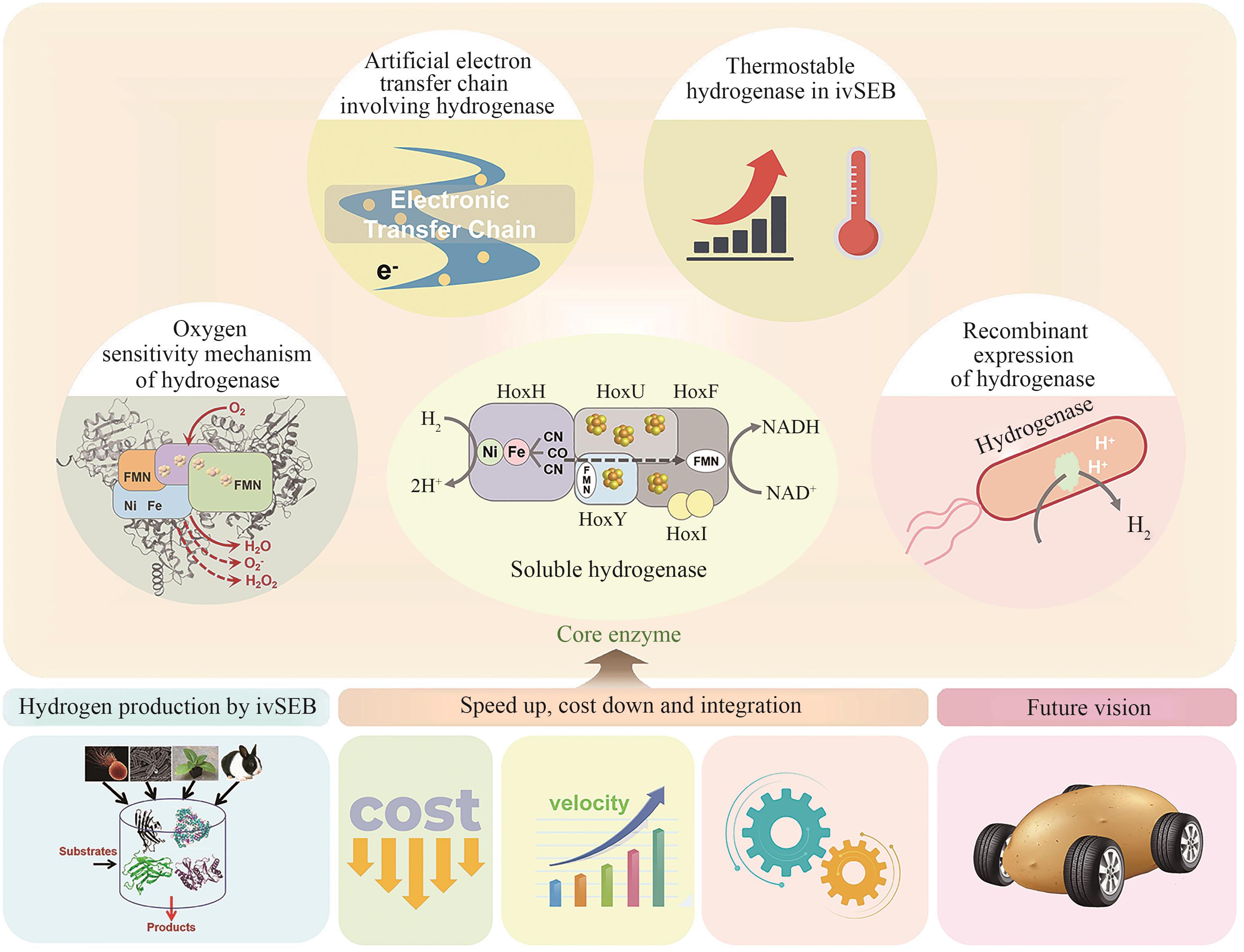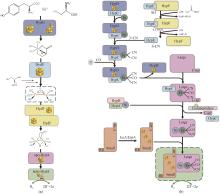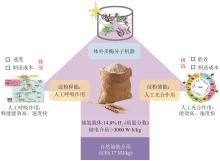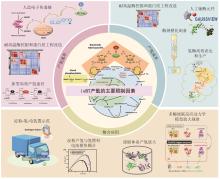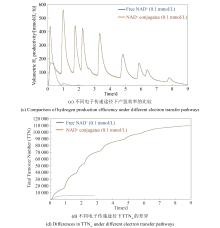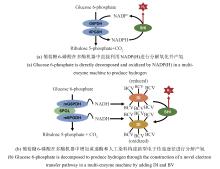|
||
|
Studies on hydrogenases for hydrogen production using in vitro synthetic enzymatic biosystems
Synthetic Biology Journal
2024, 5 (6):
1461-1484.
DOI: 10.12211/2096-8280.2024-052
Hydrogenases are the most important enzymes in biological hydrogen production and hydrogen energy utilization. They are widely distributed, oxygen-sensitive, multiunit complexed metal enzymes. In vitro synthetic enzymatic biosystems (ivSEB) is a type of in vitro biotransformation (ivBT) technology, which is an emerging biomanufacturing powerhouse that combines microbial fermentation with enzymatic biocatalysis, allowing for novel and efficient hydrogen production, also breaking the Thauer limit and achieving a yield of hydrogen close to the theoretical value of chemistry (1 mole of glucose to produce 12 moles of hydrogen in maximum). It represents the future direction of biological hydrogen production. However, the recombinant expression of hydrogenase is the main bottleneck limiting the wide application of ivSEB for hydrogen production technology. Hydrogenases are widely distributed in all life domains, but are oxygen-sensitive and mostly consist of metalloproteins with multi-subunits, bearing [Fe] only, [NiFe] or [FeFe] dinuclear core in their catalytic center. Oxygen not only inhibits the activity of hydrogenase, but also affects the transcription of the enzyme-encoding gene and post-translational process of the enzymes. As a result, the levels of recombinant hydrogenase are usually low and the enzymatic activities are also incomparable to the native enzymes, often leading to high production costs due to the strict anaerobic purification procedures. In order to meet the requirements of industrial hydrogen production, hydrogenases must possess excellent catalytic properties, such as a high catalytic turnover number, great thermal stability, and the ability to tolerate trace amounts of oxygen. This review summarizes the studies on the structural and catalytic characterizations of hydrogenases, including their classification, oxygen resistance mechanisms, and progress in recombinant expression. Additionally, the evolution of natural electron transfer chains and the design of artificial routes, which can improve hydrogen production efficiency and reduce costs, are briefly discussed. The review also discussed the progress in the studies on the mechanisms of hydrogenases’ tolerance toward oxygen, the strategies for microbial expression of recombinant hydrogenases as well as the optimization of the artificial electron transfer chains adapted for the production of hydrogen using ivSEB, in expectations of promoting the applications of hydrogenases involved ivSEB, from renewable energy storage, anaerobic artificial respiration, to clean hydrogenation or dehydrogenation in biocatalysis. 
Fig. 1
Classification of the routes to produce hydrogen
Extracts from the Article
生物制氢是另一种碳中性的氢能生产路径,以廉价的含碳生物质作为原料,利用微生物发酵或体外多酶分子机器裂解水生产氢气,这种工艺制取的氢气绿色环保能耗低,且产物硫、氮含量低,没有CO,符合氢能可持续绿色发展的需求[9]。如图1所示,根据是否使用微生物,分为微生物发酵产氢及无细胞酶解制氢,传统的微生物发酵制氢是目前能实现规模化生产的生物制氢方法,其工艺成熟且简单。其生产技术可以追溯到20世纪70年代。早期技术主要使用蓝细菌之类的光合细菌,这些微生物可利用廉价的无机盐培养基和太阳能进行物质的代谢合成,同时释放氢气,因此被认为是一种可持续的能量来源[10]。然而,其单位面积产氢速度慢且光化效率低[11]。此外,该技术还存在一些其他限制,如来自非氢酶途径的电子竞争、太阳能直接光解产氢效率低等[12]。基于生物制造“道法术器”的理论分析[13],该方法难以产业放大,进行经济性工业生产。同时,研究人员发现了许多厌氧菌或兼性厌氧菌在特定培养条件下无需光照便可稳定持续产氢,俗称暗反应产氢,针对其产氢机理已有深入研究[14]。参与暗反应产氢的宿主细胞通常具有更广泛的碳源谱和更好的生长性能,是规模化生物制氢的可能选择[15]。随着基因工程和代谢工程的成熟和发展,研究人员通过改造微生物的代谢途径,对其涉及产氢的物质和能量代谢方式以及关键酶的表达量等方面进行优化,从而提高产氢效率[12]。营养限制和底物利用等研究揭示了产氢微生物中的替代代谢途径及其多维度调控机制,但是与现有以化石资源为原料的工业规模的产氢方式相比,微生物产氢的产量及经济性均难以企及。由于微生物生长与发酵过程中能量代谢的需求及热力学反应的固有限制,微生物制氢存在一个能量转化的上限,即转化1 mol葡萄糖时理论上最多只能将其33%的还原力转化成氢气,也就是只能产出4 mol氢气,这个理论是由德国马普土壤微生物研究所的Thauer提出的,又称为Thauer极限[16]。尽管人们在菌株筛选、代谢改造、底物优化、产氢反应链改造、发酵和节能优化等方面做出努力,Thauer极限没有被打破[17-18]。高温微生物,例如Thermotoga maritima,通过突变或遗传改造可以接近这个极限,但是改造后的微生物的糖代谢速率下降,微生物的生长密度较低,产氢速率不高[19]。微生物暗发酵制氢方法还是难以产业化。
无细胞制氢主要包括多酶分子机器制氢及氢酶-光耦合产氢(图1),其中张以恒教授首先提出的多酶分子机器制氢是一种体外多酶生物转化技术(in vitro synthetic enzymatic biosystem, ivSEB),它不仅大大地突破了产氢微生物的Thauer极限,还将葡萄糖产氢的转化率提高至接近化学理论值[20-21]。多酶分子机器技术利用重组表达的酶元件,通过设计包括辅酶在内的由多酶复合体构成的催化回路,摆脱细胞能量代谢瓶颈,实现特定产物合成以及生物能量转换的人工多酶体系,迅速成为体外合成生物学的研究热点。例如,以淀粉为原料,利用该技术产氢,先将多糖降解为葡萄糖1-磷酸(G1P),通过13个酶的“一锅法”反应将其完全降解为CO2和水,并将保存于糖分子的化学能裂解水释放产物氢气[22]。因此,多酶分子机器产氢是目前唯一能够产生接近理论得率氢气的绿色温和途径,每摩尔葡萄糖可以产生近12 mol H2。2008年,英国皇家协会指出:该项研究作为一种廉价、绿色、高得率制氢的开始,是合成生物学的代表性工作,突破生物体能力极限[23]。此外,光合-氢酶耦合系统产氢也是一种高效的前沿技术,近十几年来国内外的多个研究团队对[FeFe]、[NiFe]或[NiFeSe]氢酶利用包括石墨烯在内的无机导电材料固定[24-26],将其替代昂贵的金属催化剂,可以实现太阳能的捕捉和稳定的水解产氢,这类杂合氢酶研究对于利用太阳能直接光解产氢具有重要意义[27-28]。
Other Images/Table from this Article
|
